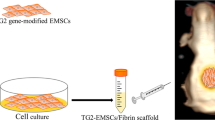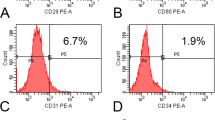Abstract
This study examines the clinical relevance of tissue engineering integrating gene therapy and polymer science to bone regeneration. Bilateral maxillary defects (3 × 1.2 cm2) in 20 miniature swine were bridged with a bioresorbable internal splint. Constructs were created using ex vivo adenovirus bone morphogenetic protein (BMP)-2-mediated gene transfer to the expanded bone marrow mesenchymal stem cells (MSCs) 7 days before implantation. Controls were performed using adenovirus β-galactosidase. The BMP-2 cell/construct displayed white solid bone formation after 3 months. Meanwhile, the hematoxylin and eosin and Von Kossa stains demonstrated exhibited mature woven bone with good mineralization. Additionally, three-dimensional computer tomography imaging revealed a nearly complete infraorbital rim repair. Quantitative analysis demonstrated a significant difference (P<0.001) in bone formation. Finally, biomechanical testing revealed no statistically significant difference in the maximal compressive strength of new bone formed by BMP-2 cell constructs and the normal maxilla. The data evidenced de novo bone formation capable of sustaining axial compressive loads. The measurement results showed that ex vivo replication defective adenovirus-mediated human BMP-2 gene transfer to MSCs enhances autologous bone formation in the repair of maxillary defects.
This is a preview of subscription content, access via your institution
Access options
Subscribe to this journal
Receive 12 print issues and online access
$259.00 per year
only $21.58 per issue
Buy this article
- Purchase on Springer Link
- Instant access to full article PDF
Prices may be subject to local taxes which are calculated during checkout






Similar content being viewed by others
References
Langer R, Vacanti JP . Tissue engineering. Science 1993; 920: 260–266.
Rabie AB, Chay SH, Wong AM . Healing of autogenous intramembranous bone in the presence and absence of homologous demineralized intramembranous bone. Am J Orthod Dentofacial Orthop 2000; 117: 288–297.
Furukawa T, Matsusue Y, Yasunaga T . Histomorphometric study on high-strength hydroxyapatite/poly (L-lactide) composite rods for internal fixation of bone fractures. J Biomed Mater Res 2000; 50: 410–419.
Pittenger MF, Mackay AM, Beck SC . Multilineage potential of adult human mesenchymal stem cells. Science 1999; 284: 143–147.
Goshima J, Goldberg VM, Caplan AI . The osteogenic potential of culture-expanded rat marrow mesenchymal cells assayed in vivo in calcium phosphate ceramic blocks. Clin Orthop 1991; 262: 298–311.
Goshima J, Goldberg VM, Caplan AI . The origin of bone formed in composite grafts of porous calcium phosphate ceramic loaded with marrow cells. Clin Orthop 1991; 269: 274–283.
Mardon HJ, Bee J, von der Mark K . Development of osteogenic tissue in diffusion chambers from early precursor cells in bone marrow of adult rats. Cell Tissue Res 1987; 250: 157–165.
Owen ME, Friedenstein AJ In: Evered D, Harnett S (eds). Cell and Molecular Biology of Vertebrate Hard Tissues. Wiley: Chichester, 1988, pp 42–60.
Ohgushi H, Goldberg VM, Caplan AI . Heterotopic osteogenesis in porous ceramics induced by marrow cells. J Orthop Res 1989; 74: 568–578.
Ohgushi H, Goldberg VM, Caplan AI . Repair of bone defects with marrow cells and porous ceramic. Experiments in rats. Acta Orthop Scand 1989; 60: 334–339.
Lou J, Xu F, Merkel K . Gene therapy: adenovirus-mediated human bone morphogenetic protein-2 gene transfer induces mesenchymal progenitor cell proliferation and differentiation in vitro and bone formation in vivo. J Orthop Res 1999; 17: 43–50.
Lou J, Manske PR, Aoki M . Adenovirus-mediated gene transfer into tendon and tendon sheath. J Orthop Res 1996; 14: 513–517.
Hogan BL, Hogan BL . Bone morphogenetic proteins: multifunctional regulators of vertebrate development. Genes Dev 1996; 10: 1580–1594.
Reddi AH . Bone and cartilage differentiation. Curr Opin Gene Dev 1994; 4: 737–744.
Horwitz MS et al. Model systems for studying the effects of adenovirus E3 genes on virulence in vivo. Curr Top Microbiol Immunol 1995; 199: 195–211.
Cohen J . Statistical Power Analysis for the Behavioral Sciences. Academic Press: New York, 1977, pp 284–288.
Yasko AW, Lane JM, Fellinger EJ . The healing of segmental bone defects, induced by recombinant human bone morphogenetic protein (rhBMP-2). A radiographic, histological, and biomechanical study in rats. J Bone Joint Surg 1992; 74: 659–670.
Gerhart TN, Kirker-Head CA, Kriz MJ . Healing segmental femoral defects in sheep using recombinant human bone morphogenetic protein. Clin Orthop 1993; 293: 317–326.
Rosen V, Nove J, Song JJ . Responsiveness of clonal limb bud cell lines to bone morphogenetic protein 2 reveals a sequential relationship between cartilage and bone cell phenotypes. Bone Miner Res 1994; 9: 1759–1768.
Muschler GF, Hyodo A, Manning T . Evaluation of human bone morphogenetic protein 2 in a canine spinal fusion model. Clin Orthop 1994; 308: 229–240.
Toriumi DM, Kotler HS, Luxenberg DP . Mandibular reconstruction with a recombinant bone-inducing factor: functional, histologic, and biomechanical evaluation. Arch Otolaryngol Head Neck Surg 1991; 117: 1101–1112.
Cook SD, Dalton JE, Tan EH . In vivo evaluation of recombinant human osteogenic protein implants as a bone graft substitute for spinal fusions. Spine 1994; 19: 1655–1663.
Wang EA, Rosen VD, Alessandro JS . Recombinant human bone morphogenetic protein induces bone formation. Proc Natl Acad Sci USA 1990; 87: 2220–2224.
Nakahara H, Bruder SP, Goldberg VM . In vivo osteochondrogenic potential of cultured cells derived from the periosteum. Clin Orthop Res 1990; 259: 223–232.
Isogai N, Landis WJ, Mori R . Experimental use of fibrin glue to induce site-directed osteogenesis from cultured periosteal cells. Plast Reconstr Surg 2000; 105: 953–963.
Breitbart AS, Grande DA, Kessler R . Tissue engineered bone repair of calvarial defects using cultured periosteal cells. Plast Reconstr Surg 1998; 101: 567–574, discussion 575–576.
Vacanti CA, Kim W, Upton J . The efficacy of periosteal cells compared to chondrocytes in the tissue engineered repair of bone defects. Tissue Eng 1995; 1: 301–389.
Lazarus HM, Haynesworth SE, Gerson SL . Ex vivo expansion and subsequent infusion of human bone marrow-derived stromal progenitor cells (mesenchymal progenitor cells): implications for therapeutic use. Bone Marrow Transplant 1995; 16: 557–564.
Mason JM, Breitbart AS, Barcia M . Cartilage and bone regeneration using gene-enhanced tissue engineering. Clin Orthop 2000; 1 (Suppl 379): S171–178.
Lee JY, Peng H, Usas A . Enhancement of bone healing based on ex vivo gene therapy using human muscle-derived cells expressing bone morphogenetic protein 2. Hum Gene Ther 2002; 13: 1201–1211.
Crystal RG . Transfer of genes to humans: early lessons and obstacles to success. Science 1995; 270: 404–410.
Roman M, Axelrod JH, Dai Y . Circulating human or canine factor IX from retrovirally transduced primary myoblasts and established myoblast cell lines grafted in murine skeletal muscle. Somat Cell Mol Genet 1992; 18: 247–258.
Resenfeld MA, Yoshimura K, Trapnel BC . In vivo transfer of the human cystic fibrosis transmembrane conductance gene to the airway epithelium. Cell 1992; 68: 143–155.
Wilson JM . Adenoviruses as gene-delivery vehicles. N Engl J Med 1996; 334: 1185–1187.
Beresford JN . Osteogenic stem cells and the stromal system of bone and marrow. Clin Orthop 1989; 240: 270–280.
Caplan Al . Mesenchymal Stem Cells-Mediated Cartilage and Bone Repair. Biological Mechanisms of Tooth Movement and Craniofacial Adaptation, Ed. Davidovitch Z., EBSCO Pub., 1992, pp 433–438.
Haynesworth SE, Goshima J, Goldberg VM . Characterization of cells with osteogenic potential from human marrow. Bone 1992; 13: 81–88.
Mason JM, Grande DA, Barcia M . Expression of human bone morphogenic protein 7 in primary rabbit periosteal cells: potential utility in gene therapy for osteochondral repair. Gene Therapy 1998; 5: 1098–1104.
Lieberman JR et al. Regional gene therapy with a BMP-2-producing murine stromal cell line induces heterotopic and orthotopic bone formation in rodents. J Orthop Res 1998; 16: 330–339.
Alden TD, Pittman DD, Hankins GR . In vivo endochondral bone formation using a bone morphogenetic protein 2 adenoviral vector. Hum Gene Ther 1999; 10: 2245–2253.
Engstrand T, Daluiski A, Bahamonde ME . Transient production of bone morphogenetic protein 2 by allogeneic transplanted transduced cells induces bone formation. Hum Gene Ther 2000; 11: 205–211.
Oakes DA, Lieberman JR . Osteoinductive applications of regional gene therapy: ex vivo gene transfer. Clin Orthop 2000; 1 (Suppl 379): S101–S112.
Baltzer AW, Lattermann C, Whalen JD . Genetic enhancement of fracture repair: healing of an experimental segmental defect by adenoviral transfer of the BMP-2 gene. Gene Therapy 2000; 7: 734–739.
Breitbart AS, Grande DA, Kessler R . Tissue engineered bone repair of calvarial defects using cultured periosteal cells. Plast Reconstr Surg 1998; 101: 567–574, discussion 575–576.
Hollinger JO, Kleinschmidt JC . The critical size defect as an experimental model to test bone repair materials. J Craniofac Surg 1990; 1: 60–68.
Lo LJ, Marsh JL, Vannier MW . Craniofacial computer-assisted surgical planning and simulation. Clin Plast Surg 1994; 21: 501–516.
Robb RA, Hanson DP . A software system for interactive and quantitative visualization of multidimensional biomedical images. Australas Phys Eng Sci Med 1991; 14: 9–30.
Heise C, Sampson-Johannes A, Williams A . ONYX-015, an E1B gene-attenuated adenovirus, causes tumor-specific cytolysis and antitumoral efficacy that can be augmented by standard chemotherapeutic agents. Nat Med 1997; 3: 639–645.
Tai CL, Shih CH . Mechanical testing of polymethyl methacrylate bone cement impregnated with bone and hydroxyapatite. Chin J Med Biol Eng 1997; 17: 1–8.
Acknowledgements
We would like to thank Professor Sing Kai Lo, Institute for International Health, University of Sydney for the statistical work in this manuscript. We wish to thank Dr Lun-Jou Lo and the Medical Imaging Laboratory for providing the CT imaging processing and measurement, and Dr Richard A Robb, PhD, Biomedical Imaging Resource, Mayo Foundation, Rochester, MN, USA, for providing the Analyze program. This research was supported by a Chang Gung Memorial Hospital Grant (CTRP008).
Author information
Authors and Affiliations
Rights and permissions
About this article
Cite this article
Chang, SN., Chuang, H., Chen, Y. et al. Ex vivo gene therapy in autologous bone marrow stromal stem cells for tissue-engineered maxillofacial bone regeneration. Gene Ther 10, 2013–2019 (2003). https://doi.org/10.1038/sj.gt.3302106
Received:
Accepted:
Published:
Issue Date:
DOI: https://doi.org/10.1038/sj.gt.3302106
Keywords
This article is cited by
-
Periostin-modified bone marrow mesenchymal stem cells from osteoporotic rats promote alveolar bone regeneration
Journal of Molecular Histology (2019)
-
Mesenchymal stem cells with rhBMP-2 inhibits the growth of canine osteosarcoma cells
BMC Veterinary Research (2012)
-
In vitro models for the evaluation of angiogenic potential in bone engineering
Acta Pharmacologica Sinica (2011)
-
Augmented anti-tumor therapy through natural targetability of macrophages genetically engineered by NK4 plasmid DNA
Gene Therapy (2008)
-
Ex vivo-transduced autologous skin fibroblasts expressing human Lim mineralization protein-3 efficiently form new bone in animal models
Gene Therapy (2008)



